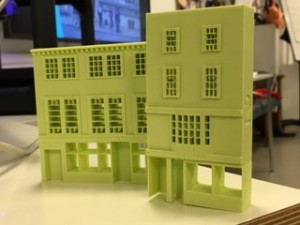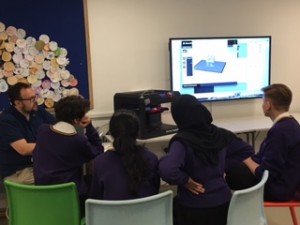 The session began with a talk about how architects are using 3D printing to design many buildings around us, which have peculiar shapes and structures. These are impossible to design without Computer Aided Design (CAD). Architectural models can then be 3D printed, which is a massive improvement within the industry.
The session began with a talk about how architects are using 3D printing to design many buildings around us, which have peculiar shapes and structures. These are impossible to design without Computer Aided Design (CAD). Architectural models can then be 3D printed, which is a massive improvement within the industry.
Our expert, Chris, said, “The way in which the 3D printer works isn’t actually that complex. It creates objects through many layers of plastic. It has a roll of plastic at the back, a tube in which the plastic travels to the beak which is heated up to 220 degrees, which then squirts out tiny drops of plastic in layers. Our 3D printer is precise to the size of human hair, there are some which are precise to the 1/5th of the human hair and can print out thousands of colours; however their cost is about £17 000.”
 Following this, small groups of students got the chance to see the 3D printer Chris had brought with him in action. They learnt about how they were already improving peoples lives through 3D printing medical equipment such as heart or jaw models. They also discovered ideas about how it will be important in the future – perhaps even 3D printing full scale buildings!
Following this, small groups of students got the chance to see the 3D printer Chris had brought with him in action. They learnt about how they were already improving peoples lives through 3D printing medical equipment such as heart or jaw models. They also discovered ideas about how it will be important in the future – perhaps even 3D printing full scale buildings!
Meanwhile, students were set the challenge of redesigning the High Street of the future. “You’re the designer. Let your imagination run wild!”
Students of Oxford Spires Academy put a lot of thought into their future High Street. Surprisingly many said they love the current “good, old High Street”; deciding that Oxford wouldn’t be Oxford without “the buildings from sandstone”.One of the students said he loved the old aesthetics of the High Street, which reminds him of the past. In many designs, students left older buildings as a tribute to the old city, but made buildings around them modern.
 When asked about ways of improving High Street answers included “more green spots, streets under ground so the cars wouldn’t make that much noise, solar panels to reduce the costs for many shops and some more facilities for leisure and entertainment.”
When asked about ways of improving High Street answers included “more green spots, streets under ground so the cars wouldn’t make that much noise, solar panels to reduce the costs for many shops and some more facilities for leisure and entertainment.”
The majority of the students said that everything was interesting about the project so far, but if they were to pick one thing that appealed most, it would definitely have to be the 3D printer.
The session concluded with students proud with their own work, and surprised at the creativity of their peers. They were very colourful and creative, with the uses of a range of materials.
